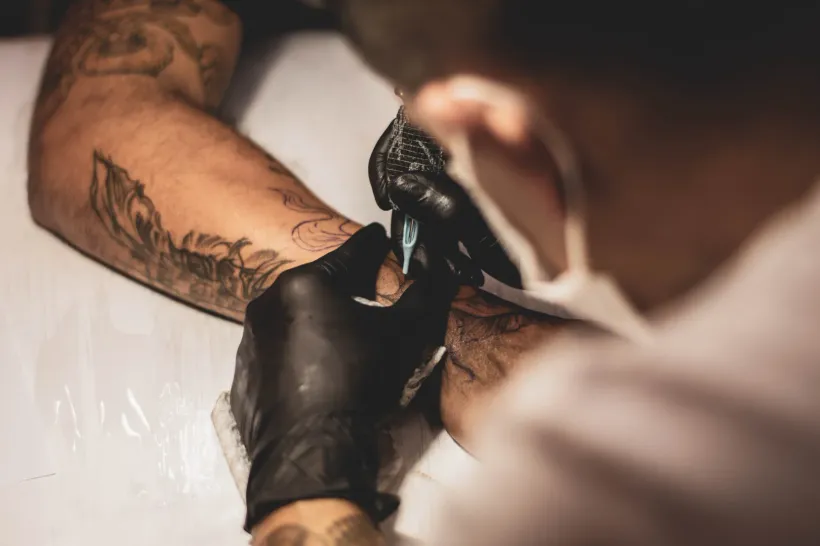!
Can programmers become tattoo artists (and vice versa)?
byKacper B
Sep 19, 2022

To answer the title question — yes, they can. I will be happy to prove my thesis in this article, but first, a few words about me and how I came up with the idea for this post.
I’ve been programming for about 5 years, but learning this profession was sometimes difficult as I’m pretty young. Anyway, it was going forward, and from the beginning, it fell on front-end development (and I do not regret this choice).
While the all-day sessions at the computer started to get monotonous, my hobby focused on the games we all know. Still, fortunately, not long after that, I was able to refocus and go into art (shall we say). With tattoos, it’s usually the case that you either love them or hate them, and I’m fortunately in the first group. At first, the creative process didn’t interest me very much. I just cared about the result until about 2 years later I found that the extended deadlines and high prices hindered me. I bought my tattoo machine, inks, and the other necessary things, and somehow it started.
Programmers (even beginners) start to look at things from a different side, for example, optimize some processes or what if (probable traumas from conducting tests). In my case, it was no different. While learning the craft of tattooing, I began to see more and more connections between these two seemingly distant professions.
As time went by, there were more and more connections to programming (although I’ve only been tattooing for about 3–4 months), so I concluded that starting a new hobby or even radically changing the industry can be much simpler than it might seem.
Therefore, based on my basic experiences as a Junior developer, I decided to describe it all from my perspective. A specific description of the two industries’ similarities (and opposites).
Due diligence
Before starting to plan a project, gathering critical information about it is essential because it is impossible to approach the planning and later implementation without it. Without knowledge, these stages seem unfeasible, and they almost always are. For the sake of this article, let’s take the design of a landing page (from the programming industry) and a sleeve (from the tattoo industry) as an example.
In the case of programming, the necessary information will undoubtedly be: what’s the purpose of the project and what are the goals? Then comes the other things like if there’s any time constraint or what’s the client vision. We start documenting the project at this stage.
Issues of tattoo design information do not stand out significantly corresponding to the IT industry. Wanting to make a tattoo, for example, the sleeve mentioned above, we need to know, first, what the design theme will be. One of the essential information will undoubtedly be the client’s health. Such as whether he has a cold, fever, allergies to the ingredients contained in the pigments, dermatitis, in the case of women, whether she is pregnant, and even whether she is taking any permanent medication. Fortunately, we can prepare a written form so we don’t accidentally miss any information when conducting the first interview. I can say that the main differences are in the dates — tattooing takes less time than developing an application (even for several sessions). Hence, the tattooist proposes dates based on his availability.
Already at the first stage, you can see significant similarities, if only the matching of the date and the general concept of the whole. There will be more of these later in the article.
Planning the project
We already have the base information from the client, so it’s time to start the work, or at least initiate it.
At this stage, it is enough to answer the question — what do I need to do to move on? It’s that simple! Well, let’s just say…
What to do to make the application not just a concept? Foremost, let’s choose a technology stack. The second significant thing is the design. Clients sometimes tend to deliver designs upfront. In this case, our job is to ensure it’s complete, the user journey makes sense, and UX clicks. If the client doesn’t have any design, we start with wireframes (block schema of all the pages) and proceed to the actual design phase.
And how is it with tattoo planning? Well, quite similarly. Admittedly, we don’t have a technology stack, but you have to choose needles, and there are almost as many types as JavaScript frameworks. The other thing — choosing the correct inks in terms of shades, saturation, etc.
The design on Figma is also not there, but I have a place on the body + artwork on paper. There are no screens either. For that, there are places to watch out for, such as moles, prominent veins, the inside of the elbow (the outside too, because tattooing “on the bone” is not pleasant, but it depends on the client), or other more sensitive places. It gets interesting when planning a biomechanical tattoo, but that’s a topic for another article. Since we have components in the application, how does it relate to tattooing? The answer is straightforward — the sleeve is made throughout several sessions, so we can treat each session as a sub-session and the minor elements as components. A straightforward analogy.
We have an idea, preliminary assumptions, and sketches, so it’s time to prepare.
To prepare for a project, what does it mean? Theoretically, it is known, but I will describe it using the example of the already mentioned projects (a landing page and a sleeve).
In the case of a project, preparation usually involves setting up an environment based on a technology stack, preparing a repository, installing packages (npm, composer, and whatnot), assigning the necessary permissions to people on the team, and the initial delegation of tasks. It wouldn’t hurt to set initial deadlines for individual milestones. In short, preparation.
And how about tattooing? In the previous section, I wrote about the selection of needles, but you can think about them now (now meaning preparing the stand). Since it will be a sleeve, it will be necessary to prepare the armrest, appropriate lighting, print the design (if it is digital, an optional point), and basically, that could be the end of it because most things are prepared at the client in the studio.

This particular stage doesn’t have a lot of common factors but rest assured. As I wrote, the tattoo artist mainly takes care of the client and the preparation of the process. On the other hand, looking for similarities — repository preparation vs. armrest preparation? Installing packages vs. selecting lighting? It may look like searching for analogies, but from my standpoint, it seems pretty similar.
Everything is prepared so ready, set, and go…
We start working on the project, delegating stuff, and monitoring whether everything is going in the right direction. The implementation usually follows the Atomic Design methodology, that is, we start with the smallest components, such as Button or Image in order to make a whole section of them a bit later, which is then assembled into a complete page or view. This approach saves a lot of time due to the reusability of the created components.
As I mentioned a bit above — part of the preparation for the tattoo realization happens right “during the realization”, i.e. disinfecting the station, setting up the components (armrest/and, lighting), disinfecting the tattooed area, and then reflecting the carbon paper on the skin. But before we reflect on the tracing paper it is necessary to agree on the design with the client, to make sure that this is what he had in mind, whether there is the right atmosphere and theme, color scheme… Well, in general, the whole thing in the context of the design. If yes — we reflect the carbon paper, if not — we correct and again carry out the ritual of getting along.
An essential issue — is the careful arrangement of carbon paper. Leaving aside the problems of transfer fluid (such fluid to make the pattern visible on the skin, quite useful), you need to avoid the aforementioned moles, scars, moles, etc.; otherwise, the pain will be multiplied, and there may even be bleeding. All of the above done? Well, we mount the needle (or needle cartridge) in the razor, embrace the final adjustments of the razor and get to work. Analogous to the project tattooing (as in any other industry), there is no point in making life difficult for ourselves, so following the proven techniques, we start doing it from the bottom so as not to smear the carbon paper with the hand.
The implementation of the projects in these two fields, at this particular stage, seems to be a complete opposite (and in a way it is), but the premise remains the same — to make things as difficult for yourself as possible, whether it’s the reusability of components in programming or accidentally not smearing yourself with the reflected pattern.
The design seems ready, but… are you sure?
We present the “finished” product to the client and wait for feedback. If something isn’t right, something needs fine-tuning, we embrace it. But let’s see how this look in detail:
We send the client a message that the project is ready for UAT (User Acceptance Testing). Then we await a list of changes to be made (almost always, the client will send a list because the concept changed slightly in the course). Once we receive the list, we roll it out to the devs in shuffles and “resume” the work. Then we test, QA, send it to the client for a final round of review and fly on.
With tattooing, it’s very similar, but the difference is that we don’t send the project to the client. Still, we get along with everything on the spot. Whether the shadows are correct, fillings, the thickness of the lines, and generally, all the things that can be changed. If there is something to hit (such as the thickness of the outline or the intensity of the shadows), then we correct it and make sure it’s okay. If it is, then great. :)
Immediately, you can see the analogy — when finished, we consult the result with the client and make any corrections. Simple.

Release
The client has accepted the project after the changes (thinking utopian without any adjustments). The billing is settled, so we move on to the final act.
We move the application and database to the production server, perform migrations and imports (if required), and check everything works as it should in the production environment. Then we just switch the DNS delegation to route the traffic to the new website.
We won’t put the tattoo on the server because we work on production right away ;) On the other hand, it is imperative to provide the client with information about the care of the new artwork on his body.
Foremost — the first two weeks, which means moisturizing with cream, possibly avoiding the sun and long baths, dust, and infections (a tattoo can be treated like an open wound, so hygiene is vital).
After two weeks, avoiding excessive sun exposure or sunbathing (unless using sunscreen) would still be a good idea.
In both cases, it’s about the absolute satisfaction of our client and ensuring that everything goes off easily. Keep in mind technical support (in case of a project), or a simple “helping hand” after the tattoo is done.
Summary
In conclusion — experience in one industry can help incredibly in another, even one that seems to have nothing to do with the previously performed. Analogies can be seen everywhere (or almost everywhere). Sometimes you just have to notice them.
I might as well write an article about analogies in the catering-management industries, but unfortunately, I don’t have enough experience with them to put it into words meaningfully.
Remember that it is good to have a hobby even to kill time or do self-development because passion and work create unlimited possibilities for your growth in many way.
Kacper B
Former Junior Front-end Developer at Department of Web
